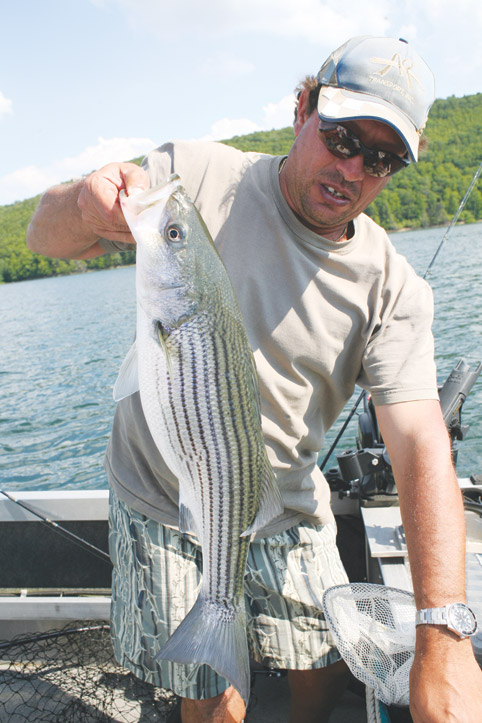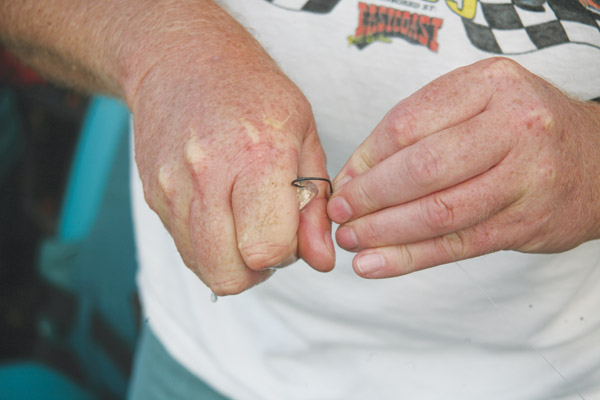 Fish & Tackle: Slow-Trolling for Stripers
Fish & Tackle: Slow-Trolling for Stripers
By Fish & Tackle Editor Vic Attardo

The taut downrigger wire hummed its deep-water tune. Fifteen feet below the stern, a trio of live herring were swimming in the cool, early summer water. Three 7-foot rods were bowed in their holders ready to snap if a big striped bass took the bait.
The manner in which we were fishing aboard the Gully Whumper might appear more suited to ocean work, but this was a freshwater lake, just under 1,000 acres in eastern Pennsylvania. We were trolling at barely 1 mile an hour, using live bait and cannonballs, and being successful at it. Already two stripers had come aboard. Both weighed about 8 pounds and measured over 28 inches, but we were hunting for a bigger prize.
Striped bass and hybrids, known as “wipers” because they are crossbred with white bass, have become the big fish in many freshwater lakes. Stocked by state wildlife agencies from the East Coast to the West, they are providing the best chance to catch a freshwater fish that one holds with arms outstretched.
Striped bass is a good name to describe this member of the true bass family, with silver sides and seven or eight dashed lateral lines across the flanks.
Ordinarily, the striped bass is not a shallow fish. It may crash a shoreline or work along a shallow bar, but primarily, it is an open-water cruiser. Striped bass do not lurk in structure like largemouth or smallmouth, looking to ambush prey. Instead, striped bass work in true schools, attacking like an invading army.
Striped bass adapt well to most lakes. However, to keep the stock up, fry or fingerling stockings are often needed. Pennsylvania typically adds between 15,000 and 20,000 fry or fingerling a year to the 1,000-acre lake we were fishing. They grow to hefty proportions in three to five years. As they mature, they locate the lake’s deep water and become masters at maneuvering below, through and above thermoclines. When feeding, stripers may rise into the warmer surface water for prey then return quickly to the deeper water.
We were trolling over a drop-off that fell from 20 to 70 feet. Curved arches on the sonar screen showed fish tight to the drop-off at about 20 feet, suspended near the shelf. Our baits were set to troll between 12 and 15 feet. Watching the sonar, we could see the bass rising beneath them.
On a flasher, you follow the colored line that is the bait. Then, beneath the bait, a brighter line represents the bass coming. When the line that represents the bait is engulfed by the wider line that is a fish, expect one of the lines to be pulled from the downrigger clip.
Later that afternoon, we were cruising over 90 feet of open water, several hundred yards out from any discernible structure. The stripers spread out in this seemingly featureless zone as the evening lengthened, holding close to the surface, at about 15 feet. As the arches appeared on the screen, we lifted our baits to about 10 feet, and we caught bass.
Both of the bites demonstrate the willingness of stripers to rise through warmer water to grab a bait. We didn’t see any surface activity, neither the bass nor the bait broke the surface, but the stripers were definitely feeding then retreating to cooler water. During late spring and early summer, the best bet is to troll for suspended stripers at moderate depth rather than at great depth. Stripers on the bottom are not as active.
Another sign on the sonar that stripers are feeding is the behavior of the schooled baitfish. Before the bass appear, we often see these prey fish spread out several feet below the surface. On the graph sonar, the schools are loose and difficult to discern from surface clutter. But once the bass appear, the schools quickly ball up . When we see tight balls of suspended bait, we know things are happening.
The bait is called “herring” at the shop, but it’s really alewives. (Strictly speaking, alewives are a member of the herring family.) In the central part of the state, where anglers with a permit often net their own, the same baitfish is called alewives. In the South, I have seen this same baitfish labeled “large shiner.”
By trial and error, we’ve gone through a number of different rigging methods, including opening the herring’s mouth and putting the hook through the upper lip and also hooking them through both lips. These methods proved unsatisfactory. Instead, hook the bait crosswise above the nostrils in front of the eyes. Just run the hook point in one side and out the other.

We use circle hooks, size 3/0. The most important reason is that stripers will swallow a live bait and become gut hooked. Circle hooks more or less prevent this. In a recent spring, 21 of the 25 stripers we caught on circle hooks were hooked in the gristly corner of the mouth. Since stripers need to be released quickly to survive, keep the pliers ready. If we are having serious difficulty removing a hook, the line is cut and the fish released immediately.
Circle hooks also increase the strike-to-hook-up ratio.
Even when a striper chomps down hard on a bait, a straight-shank hook may slide through and not hook. But a circle hook rotates through the striper’s mouth, up to the corner, where the connection is made. And there is no need to set the hook. The moving boat and fish do it for you. With a nostril-hooked alewife on a circle hook, you won’t miss often.
We use downriggers for the ease of setting and maintaining depth. Drop the ball down to 10 feet and you can expect the bait to ride behind at 8 to 12 feet. When using a downrigger, we trail 60 feet of line from the clip.
We also use Mini Big Jon Otter planer boards, sacrificing easy depth precision on those lines to get the baits out from the boat. When a striper is spooked by motor noise and the downriggers, it moves out and away—right to the planer board baits. The depth of planer board lines can be set somewhat imprecisely with split shot.
The main line goes through the capsule attached to the planer board, and a 3-1/2-foot leader of 15-pound fluorocarbon is then attached to the line with a barrel swivel. Add a large bead to the line above the swivel so the board will not slide down over the swivel when you set the hook. Split shot are pinched onto the line just below the swivel. Rigged this way, our planer boards drag a bait about 7 to 10 feet below the surface, at a typical speed of 1/2-mile per hour.
In addition to trolling, we may just drift short distances with the wind, using both planer boards and cannonballs. This can be effective when the bass are skittish.
Also, it’s wise to keep a rod or two rigged for casting when stripers do come to the top.
I may toss a suspending jerkbait, spoon, floating stickbait or a large lipless crankbait into the froth and foam that is a rising school, but I prefer to throw the same live bait we are trolling, and for this, I like a 7-foot medium-heavy spinning rod teamed with a high-hat arbor reel and 14- or 17-pound-test line.
Again, I use a circle hook, and one of the harder measures of self-control in fishing is to not set that hook when a big bass whacks the bait.
At the strike, do nothing. Instead, wait for the bass to swim away with the bait. Then slowly collect any slack from the line, reeling and lifting the rod tip if necessary. A strong downward bend of the rod will tell you when the fish is hooked. There’s no need to snap the rod up then, just continue reeling.
When the boat traffic is light, you may catch them all day. But the best times to fish for summer stripers are mornings and evenings. I particularly like the evening bite, which may last for an hour or two on better days. No matter when you hook a striper, expect to do battle.